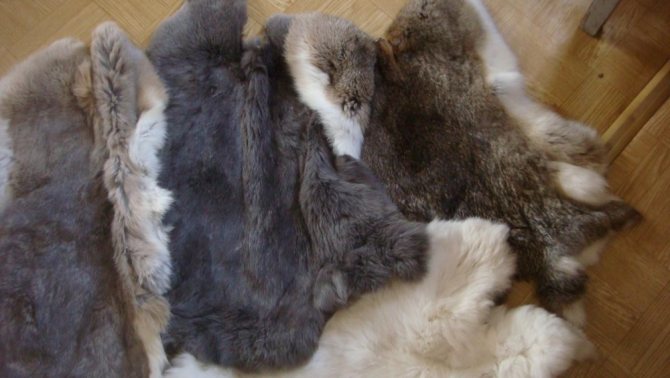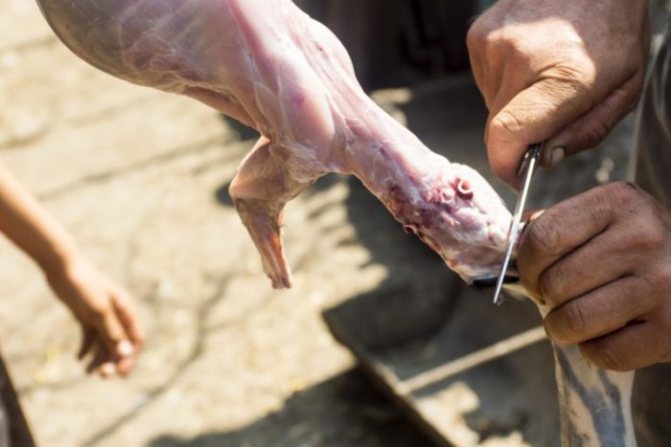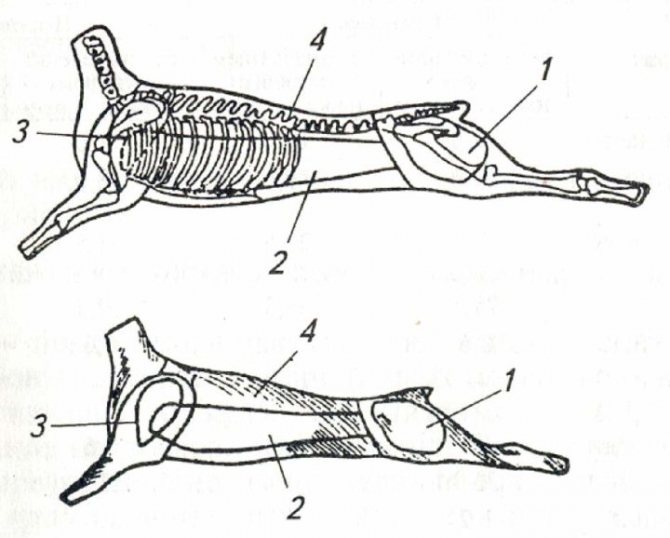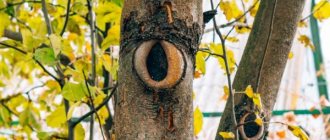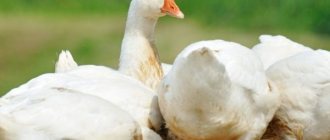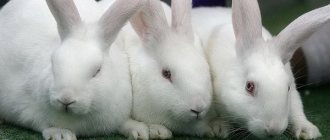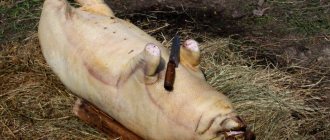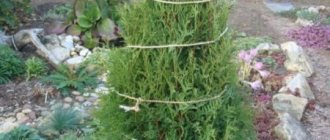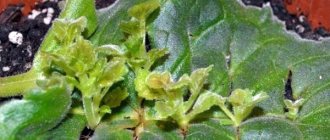How to butcher a rabbit - the best methods for slaughtering and handling a carcass
For many novice breeders, slaughtering and butchering a rabbit is a challenge. It is important to carry out these operations correctly, as incorrect actions can affect the quality of the resulting meat and skins. Experts have developed several ways to quickly and easily slaughter the animal and process the carcass. Following the instructions, even an inexperienced farmer can carry out these procedures on a par with a professional.
Rabbits are bred to obtain healthy dietary meat and soft, warm fur, which is used for sewing outerwear and shoes. In order to extract high quality rabbit products, it is important to prepare the animal for slaughter on time and correctly.
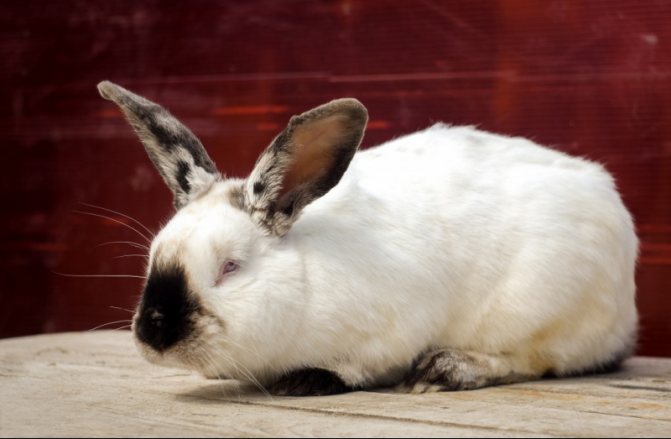
To obtain meat products, rabbits of meat breeds (flanders, New Zealand white) are bred. They tend to quickly gain muscle mass. Previously, they were kept up to 4 months of age, but thanks to selection, many early maturing breeds have been bred. Such rabbits, subject to balanced feeding with compound feed, are slaughtered after reaching 60–75 days.
In order to obtain skins, representatives of downy breeds (white downy, angora), which are famous for their luxurious fur, are bred. In order for their skin after slaughter to meet all quality standards, animals are raised for 8 months. Such rabbits are slaughtered in winter, after the end of the change of wool. If the animal has dark spots on the skin and fluff climbs, then the molt is not over yet. After its completion, the skin becomes light, monochromatic, and the rabbit fur becomes dense.
Novice breeders should know that rabbits can be slaughtered no earlier than 30 days after the animals are vaccinated.
The "eared" ones selected for cutting are placed in a separate cage the day before the operation. 12 hours before slaughter, the animals are no longer fed, and only drinking water is given. This cleans the intestines of the animal, which facilitates the evisceration and processing of the carcass.
Rabbits are advised to be shown to the veterinarian before slaughter to ensure that they are healthy. It is strictly forbidden to eat the meat of a sick animal.
Before you send the rabbit under the knife, you need to prepare the following items:
- bucket with water;
- clean rags or towels;
- a club or hammer to hit an animal on the head;
- 3 basins or pans for entrails, blood and carcasses;
- a sharp knife for cutting a rabbit into portions;
- special knife for skinning.
For slaughter, you need to equip a place. Take a special stick-spacer, both ends of which must be sharp. It is tied up with ropes on a horizontal base (for example, a strong tree branch). The killed animal will subsequently be suspended on it. It is necessary to cut and process the rabbit carcass in a place where the child will not see the shocking picture.


There are many ways to slaughter rabbits. Each of them is aimed at quickly killing the animal.
The individual is taken by the hind legs and hung upside down. When the rabbit stops resisting, it is struck with a stick or hammer on the parietal part of the skull, behind the ears. The blow should be sharp, strong enough to hammer the "eared" one, but at the same time not crush the skull. If the operation is carried out correctly, the death of the animal will occur immediately, blood will flow from its ears and nose.
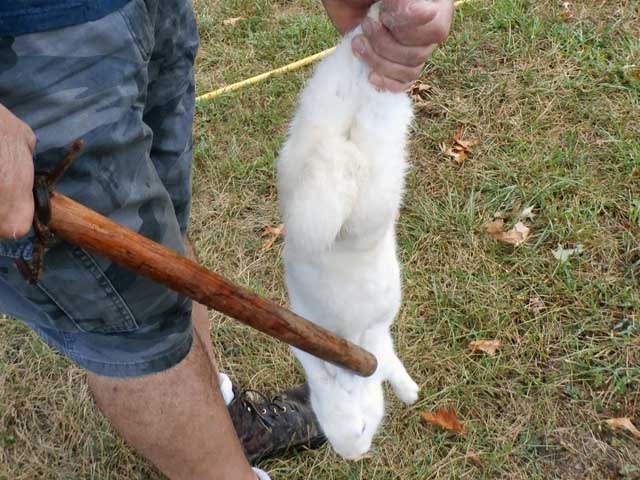

Other methods are used to kill a rabbit:
- Fracture of the vertebrae by collapsing the neck.
- Slaughter with electricity. The current is supplied to the temples of the animal. This method is rarely used in a private house, it is used in large farms.
- Air injection into a vein. A large amount of air is injected into the large veins located on the ears with a syringe. Death does not occur immediately.
- Puncture of the skull with a needle. A puncture is made in the eye area with a special device equipped with a needle. The animal dies quickly and without suffering, if you find the right point where to prick.
- The French method is used in European farms. "Eared" in a horizontal position is taken by the ears and hind legs. Then their hands are thrown up sharply. The animal dies instantly.
The rabbit can also be slaughtered. But this method is not relevant, it is rarely used.
The killed rabbit is suspended on a spacer by its hind legs. Cuts are made in the legs and the sharpened edges of the stick are threaded there. In order for the blood to drain completely, the nostrils of the "eared" are incised, and the eyeballs are removed and the artery, which is located in the larynx, is cut. This procedure lasts no more than 7 minutes. After its completion, you can skin the animal.
You can remove the rabbit skin by leaving it on the spacer. With a knife, incisions are made in the hind legs around the hock joints. Then the blade is passed from one paw to the other through the groin. The tail, forelegs and ears are removed and the skin is neatly pulled together. The head is cut off or skinned by cuts along the eyes, nose, and mouth.
To eviscerate the carcass, it is placed on its back, on a cutting board. The belly is cut along the white line that runs along the entire belly. It is important to use the knife carefully, without haste, so as not to damage the gallbladder or bladder. First, the genitourinary organs are removed, then the digestive organs, liver, heart and lungs. The kidneys are left in the abdominal cavity. At the very end, the head is cut off.
Rabbit kidneys do not have an unpleasant odor, they can be cooked immediately without soaking.
Then the rabbit is cut into portions. He has, although not large, but very strong bones, they should not be chopped.
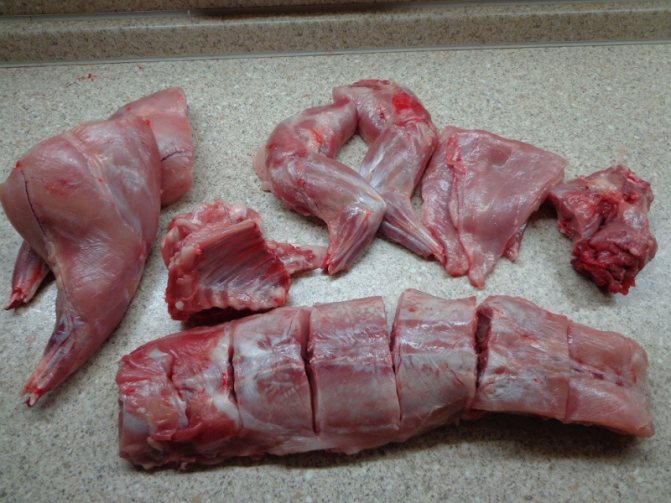

You can cut a rabbit into pieces at home like this:
- 1. Initially, the front legs are removed. The carcass is placed on its side and the limbs are removed, making an incision from the shoulder to the neck.
- 2. Optionally, you can cut off the sirloin meat from the body.
- 3. Separate the hind legs. They are cut off in the pelvic area where the joints close.
- 4. Tendons are cut between the vertebrae and the carcass is broken into 2 parts.
- 5. Separate the ribs.
- 6. The back part is divided into 3 pieces or more (depending on the size of the carcass).
To improve the taste of the meat, experts advise not to cook the rabbit meat immediately after cutting, but to put it in the refrigerator for 10-12 hours.
Step by step instructions on how to butcher a rabbit
To carry out this procedure, it is recommended to acquire a very sharp knife, then the cutting process will take place quickly and efficiently. You need to do the following:
- The first step is to start cutting from the front legs. It is very easy to separate them from the body, since they are not attached to it by bones.
- The next stage is the belly, this piece of tender meat is also easy to cut off, because it does not contain bones.
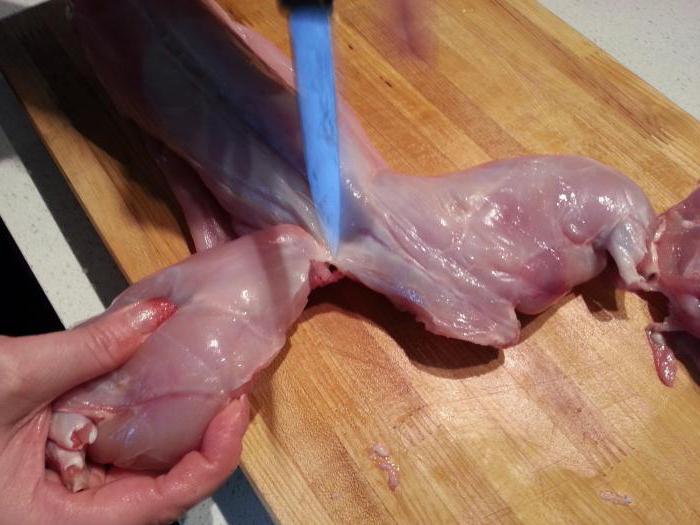

- Next, you need to separate the fillets along the entire length of the back. You should start the separation of the sirloin from the pelvic region, then with a knife you need to go in the direction of the head along the ridge and to the very neck. Fillets are cut in portions into several parts, how many of them should be directly dependent on the size of the animal. It is worth noting that the separation of the fillet from the bones is not a prerequisite, it can be left on the back, thereby the back pieces will be more fleshy.
- It's the turn of the hind legs. The knife should be inserted just below the spine and then cut downward, separating the leg through the joint.It is recommended to separate the legs from the body exactly through the joint, as this is the easiest and correct way.
- When all 4 legs are separated from the carcass, a cut must be made exactly in half in the lumbar region. It is in the center of the animal that the weak bones are located - it is enough to press a little to break them, and then all that remains is to cut the muscles.
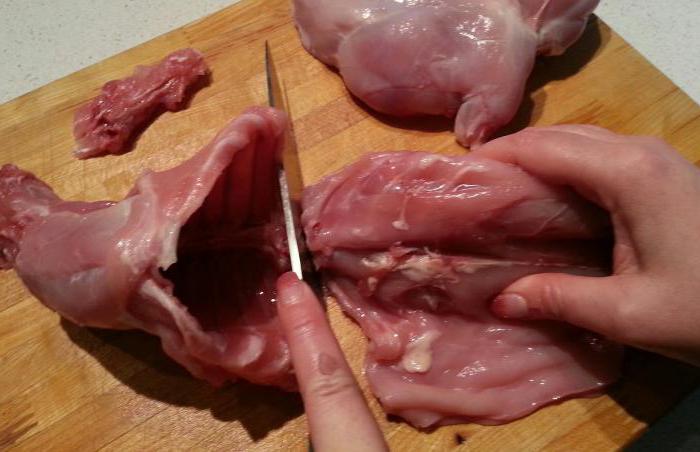

- The ribs must be separated from the spine using kitchen scissors. However, rabbits can be very large, and scissors cannot cope with such bones, so you still have to use a hatchet, but they need to be very careful when wielding them so as not to split the bones into many small fragments.
- The back is cut into several portions, their number directly depends on the size of the rabbit.
After the cutting of the rabbit has been completed, there should be: 4 legs, 2-4 loins, 2 pieces of belly, 2-4 pieces of back. Note that if the rabbit is large enough, the hind legs can be split in half so it can be cooked faster.
Slaughter of rabbits at home: methods, tools, skinning, butchering the carcass


The slaughter of rabbits is an integral part of the farmer's activity, because the breeding and maintenance of these animals is done for a specific purpose - for the sake of obtaining meat and skins. The owner of the crawling farm should know when it is best to kill pets and what methods are used for this. It is important to choose a method of slaughter that not only turns out to be humane in relation to animals, but also helps to preserve the integrity of the skins.
Output
Rabbits are bred for meat and quality fur. Many novice farmers are faced with the question of how to properly hammer and cut a rabbit. Of course, the easiest option is to find a person who is involved in this business. If you are going to breed rabbits and build a business on this, you need to learn how to do everything yourself.
Before slaughter, rabbits are placed in separate cages and starved for 12 hours. This approach empties the stomach and simplifies the subsequent meat processing process. Rabbits are killed in several ways. The most humane is electroshock. After slaughter, the carcass is hung upside down, making incisions in the nasolabial region or cutting out the eyeball so that it bleeds.
This is followed by the process of skinning with fur. If you plan to sell the skins, you should be very careful when removing them from the carcass. The skin of rabbits tears very easily, therefore, it is far from immediately possible for beginner breeders to remove it correctly. Then, from the inside of the skin, the remains of adipose and muscle tissue are removed.
Before proceeding with cutting, the skins should be properly processed. After that, they begin to gut the carcass, gently pulling out the insides. Particular attention should be paid to the color of the internal organs. If the liver is not dark red, then the carcass cannot be eaten. Then the carcass is cut into portioned pieces, if desired, having previously separated the fillets.
At what age are rabbits slaughtered?
If rabbits are raised only for meat production, then the timing of slaughter does not matter. When pets gain weight, they are sacrificed. However, most farmers want to sell skins profitably, and their quality depends on several factors:
- from the season;
- on the age of the animal.
Rabbits born in winter provide their owner with the best skins. They can be slaughtered 4 months after moult, when the animals have finished their second molt. There is no point in killing animals that were born in the summer in the fall, since the quality of their wool does not meet the requirements. Summer offspring have to be fed until the end of November or even the beginning of winter to get good skins.
Important! The timing of slaughter depends on the condition of the fur of the pets. Wait until the molt is complete before slaughtering the rabbits.
It is easy to determine the end of the molt - at the final stage, the hair changes in the area of the rump and tail. When hair loss stops in these places, and new ones grow instead, the molt comes to an end. In colored rabbits, the skin changes color, when the hairline changes, it darkens. A light skin tone indicates that the molt has already ended.
Important! If the coat breaks off easily and the down is dusty, it is too early to slaughter the rabbit.
Primary processing
Treatment
When there are a lot of rabbits on the farm, it is a pity to throw away the skins. The thought rushes about: “What to do with this? ". There are ways to use it, first treat it, that is, remove fat, subcutaneous film, muscle residues. To do this, use a special blank. On a board rounded at one end, a freshly removed skin is pulled inward with fur. Scrape with a small knife, at right angles to the skin.
After cleansing, it is pulled over the frame (rule). Make the frame yourself from wooden planks or thick wire. In shape, it is similar to the letter A with a length of one meter. Correctly stretched skin has a width in the middle of the frame 3 times less than the length, and the rump is 1-2 cm wider than the middle.
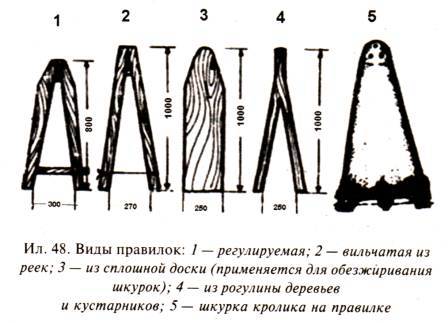

Types of rules: 1- adjustable; 2 - forked from rails; 3- from a solid board; 4- from the rogulin of trees and shrubs; 5- skin on a wire
The frame has a movable crossbar and its two arms are freely fixed at the top. This allows you to stretch skins of any size. She puts on the frame with the fur straightened down. Fasten the bottom edge so that it does not shrink when drying.
It is important to choose the right place for drying. This should be a warm, ventilated area. Drying mode - no higher than 300, otherwise the skin is very dry and becomes brittle.
Do not use a damp and cold room - the skins will become moldy. But you can store it in the cold. Dried they are put in a bag, protecting them from moths, mice and other domestic animals.
Slaughter preparation
Before slaughter, animals are not fed for 12 hours, it is only allowed to give them water. This measure will avoid contamination of the wool during slaughter. Shortly before the killing procedure, the fur of the pets is checked for tangles and dirt. If necessary, wash the contaminated areas with warm water. With the help of a brush, the wool is put in order, getting rid of the fallen hairs.
Attention! Before slaughter, animals are examined by a veterinarian if their meat is intended for sale and not for personal use.
The farmer needs to prepare the slaughtering tools. They can be different, depending on the chosen method of killing animals:
- a stick, one end of which is wrapped in rubber;
- electrodes;
- syringe;
- pin-needle.
In addition to the listed tools, you will need several knives - one for bleeding, the other for skinning, a stick-spacer for hanging the animal. You also need to prepare containers for collecting blood and internal organs, a basin of warm water, soap and a towel.
What to do after slaughter
Once the stunned animal is quiet, it needs to make an incision in its throat to drain the blood. Next, you should hang the carcass on the prepared board by the hind legs, securing the latter, for example, with wire. At the bottom, you should install a basin or some other utensil for collecting blood and for the viscera. If desired, the rabbit's head can be removed immediately.
Dogs, if present in the yard, should be driven away from the place of slaughter and butchering. You cannot give the giblets of a slaughtered animal to these animals. It is believed that rabbits can be carriers of all sorts of canine diseases.
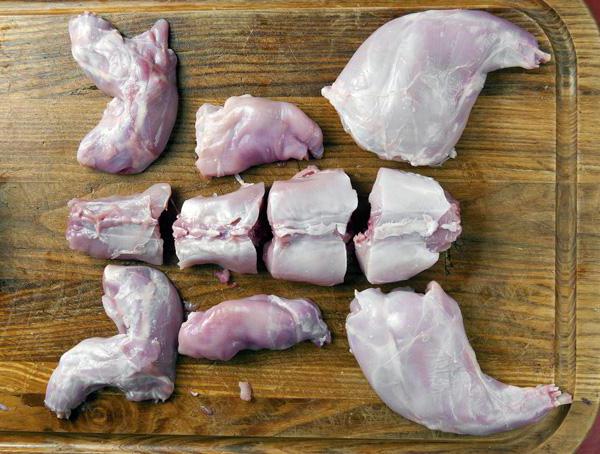

Of course, you should start cutting the carcass immediately after slaughter. In no case should you be late with this procedure. Within a few minutes after slaughter, various harmful microorganisms begin to multiply rapidly in an uncut carcass. Therefore, it will be unsafe to eat it.
Slaughter methods
There are several ways to slaughter a rabbit at home.These include:
- stunning;
- French method (stretching);
- electrical discharge;
- firing pin;
- air embolism method;
- fracture of the neck.
Each of the methods allows you to humanely kill a rabbit, but experience is needed. If you are going to kill an animal for the first time, it is worth inviting a person with experience so that you do not have to observe a terrible picture - the death agony of a pet. Let's consider each method in detail. Having received an idea of all possible methods of slaughter, each farmer himself will choose the one that seems to him the simplest and most humane.
Stunning
To kill the animal by stunning, you need a stick of medium thickness. One end is wrapped with cloth or rubber, so as not to spoil the skin during the impact. The animal is carefully removed from the cage, taken by the hind legs. It is advisable to do everything calmly and quickly so that the pet is not frightened.
Killing the animal by stunning
The blow is applied in the back of the head, it must be accurate and strong enough. If done correctly, death will occur almost instantly - within 10 seconds.
Attention! If the blow is too powerful, there is a possibility of spinal cord injury. This should be avoided because it will cause the heart to stop immediately, making it difficult to bleed the carcass.
After completing the procedure, the rabbit's body is suspended upside down on a spacer stick. Its pointed ends are inserted into the hind legs in the area near the hock joints. It is important to accurately determine the puncture site, it is located between the bone and tendons.
The blood is drained immediately after stunning and hanging the carcass. For this, various techniques are used:
- remove the eyeball;
- cut the blood vessels of the throat with a knife through the mouth so as not to damage the skin;
- some farmers cut their noses to drain the blood.
Attention! The bleeding procedure lasts 3-5 minutes.
French method
According to the French method, slaughter is carried out without any tools. To do this, you only need a flat, hard surface on which the animal is placed. The pet is grasped with one hand by both ears, and the other by the legs. After waiting for the animal to calm down a little, they stretch its body in opposite directions with a sharp movement. Death occurs as a result of rupture of the tissues of the spinal cord and blood vessels of the neck.
Attention! The movement of the cutter must be sharp and strong.
Electric shock
Not all farms have the ability to kill a rabbit with an electric discharge, as this requires electrodes. The point is to pass a current through the body of the animal, then death will come quickly. One electrode is fixed on the hind limb of the animal, in the thigh area, and the other - on the temple or on the back of the head. Then a voltage of 220 V is applied for a short time. The recommended current strength is 5-6 A. Usually, the animal dies in 3-5 seconds.
Required inventory


In order not to delay the cutting process, you must immediately prepare all the necessary items. It is recommended to take the following inventory:
- Sharp knife. There are no specific rules on what size the knife should be. You should take the one that the separator likes best, the main thing is that it should be sharp.
- Cutting board. It is recommended to use a plastic board on which only raw meat products are cut. If there is none, you can use a regular wooden one.
- Kitchen scissors. They are needed to cut the ribs.
- Latex gloves. They are necessary so as not to damage your hands on the bones when cutting the carcass.
- Hatchet. It is only needed if the culinary scissors cannot cut the bone, its use is highly undesirable.
How to skin properly (skinning)?
The skin is removed from the carcass after complete exsanguination. For this, the rabbit is suspended by its hind limbs on a stick-spreader or hooks.How is flaying, instructions:
- First, circular incisions are made in the area of the hocks on the hind legs.
- From them, a knife blade is carried out along the inner contour of the thighs, moving in the direction of the anus. The tail is removed (cartilage is removed from it). In the future, this part of the skin can be used to make pom-poms or toys.
- Grasping the skin with both hands, it is pulled towards the head of the carcass.
- Then the front legs are cut off.
- The auricles are cut off and circular incisions are made near the eyes.
- The rest of the skin is easily pulled together.
After removing the skin, you need to start processing it. A thin layer of fat is removed from the inside using a sharp knife. In this case, experience is needed - one wrong move, and the raw materials will be spoiled. For dressing the skin, a special tool is used:
After processing, the skin is sent for conservation. It dries in a well-ventilated room for several days. Dampness, cold and heat can damage raw materials.
Skinning removal
Butchering a rabbit is just one of the steps towards making delicious dietary meat. A live rabbit will have to be killed and gutted.
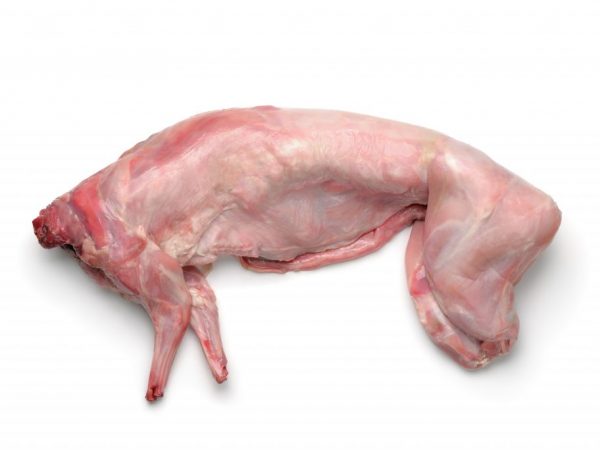

Skinning is best done immediately after bleeding is complete, before the rabbit is numb.
Before cutting the rabbit skinning. Skinning has its own characteristics. The killed animal is placed with its stomach on a board, its skin is pulled with fingers at the spine, where a small incision is made with a knife. Fingers are inserted into the incision and try to undress the carcass with movements towards the head and tail of the animal.
When the skin is separated from the body of the rabbit, it is removed from its limbs. It will be possible to completely separate the skin after breaking the bones and making incisions in the tendons and muscle tissue. The tail is removed with a knife, the crawl is decapitated next to the first vertebra. The carcass of the animal is ready for cutting.
How to cut a carcass?
The carcass begins to be cut immediately after skinning, while it is still warm. The rabbit is cut like this:
- First, a vertical incision is made in the peritoneal region. Fingers are inserted into it and the urinary and gall bladders are carefully removed. It is important not to damage them so as not to spoil the meat.
- Now you can remove other organs - intestines, liver, lungs. The kidneys are left inside the carcass.
- The head is cut off in the region of the last cervical vertebra.
- To give the carcass a presentable look, it is molded. For this, the forelimbs are inserted into the incisions in the region of the 3 and 4 ribs on both sides.
- The hind legs should be aligned and fastened together.
Every farmer should know how to slaughter a rabbit, remove the skin from it and process it. Without such experience, it is better to ask a knowledgeable person to show how this is done. It will take some time to master this science. Having made the decision to breed fur-bearing animals, you will have to learn how to kill them in cold blood.
Veterinary and sanitary examination
After cooling, the carcasses are sorted and marked. Sort carcasses according to requirements. Carcasses should be fresh, well bled, without internal organs, except for the kidneys, the head should be removed at the level of the first cervical vertebra, the front legs should be at the wrist, and the hind legs should be at the hock joints. The cooled weight of the carcass must be at least 1.1 kg. Rabbit carcasses are divided into cooled, chilled, slightly frozen, and according to fatness and quality of processing - into the first and second categories.
Table of changes in meat yield in rabbits of different breeds, depending on the age of slaughter
| Breed | 65 days | 110 days | 135 days | 270 days |
| White giant | 46,2 | 53,2 | 59,8 | 60 |
| Gray giant | 45,4 | 53,4 | 59,2 | 59,1 |
| Black-brown | 46,4 | 52,3 | 57,5 | 57,9 |
The first category includes carcasses with well-developed muscles and fat deposits at the withers and groin in the form of thick stripes, almost half of fat.
The second category includes carcasses with satisfactory muscle development, slightly protruding spinous processes of the dorsal vertebrae and minor fat deposits at the withers, groin and around the kidneys. This category includes carcasses with satisfactory muscularity but no body fat. Non-standard carcasses are used for catering and industrial processing.
Rabbit carcasses are marked in accordance with the instructions for branding meat. On the outside of the drumstick, a round stamp is imposed on Category 1 carcasses, and a square stamp on Category 2 carcasses. Rabbit carcasses are packed in wooden boxes separately by category, no more than 20 in each box. The carcasses are placed in one row, with parchment paper between the carcasses. The boxes must be clean and dry. The bottom and sides of the boxes are lined with wrapping paper. Each box is marked or labeled.
Preparation for slaughter: age for slaughter
On the one hand, the meat of old rabbits is not very tasty, but on the other hand, if you slaughter an animal that is too young, there will be little meat. Therefore, it is very important to know when is the right time for slaughter. It should be borne in mind that this period may be shifted, for example, due to animal disease. As a rule, very young rabbits are not slaughtered, as this is unprofitable. Of course, nursing and expecting rabbits are not subject to slaughter (unless, of course, they are sick with a dangerous intractable infection that threatens the entire livestock). If a disease is rapidly spreading among the animals, there should be no time with slaughter.
Slaughter preparation
Note! The age at which rabbits are slaughtered depends on their rate of weight gain. If animals are gaining weight quickly, the usual period can be made a little earlier. And, conversely, if the animals are slowly gaining weight, there is no need to rush.
How long the rabbit grows before slaughter depends on the breed. Small and dwarf breeds gain weight faster than large ones.
With regard to the age suitable for slaughter, the following must also be borne in mind:
- If rabbits were born in winter, slaughter can be carried out when they are already 4-5 months old.
- Animals born in summer are ready for slaughter around November, when the molt process is complete.
- If the animals have been vaccinated (for example, against rabies), slaughtering will have to wait about a month, otherwise the meat may become infected with the bacteria of the disease from which the vaccination was carried out.
- It makes no sense to kill animals that do not yet weigh 1.5 kg.
Note! The general health of the animals must also be considered.
Features of rabbit meat
As you know, a rabbit is not only valuable fur, but also 3-4 kg of dietary easily digestible meat. And no matter how much we love these fluffy big-eyed animals, from time to time we have to eat them. For example, for disorders and diseases of the gastrointestinal tract, overweight, problems of the cardiovascular system and food allergies, doctors strongly recommend eating rabbit instead of pork, beef and even chicken.
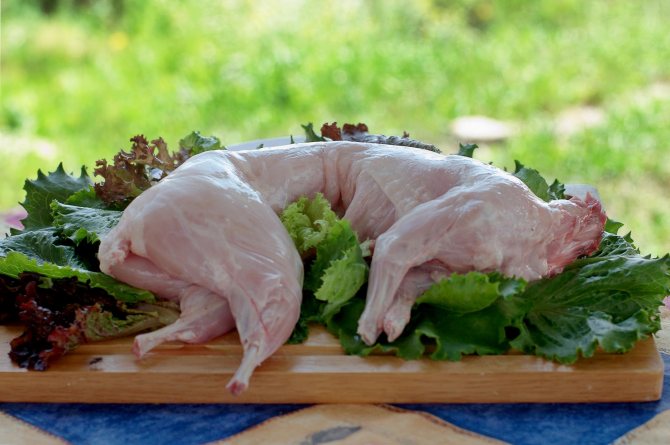

Rabbit meat is lighter and healthier than pork, beef and even chicken
Rabbit meat is low-fat and low-calorie - only 156 kcal per 100 g. In addition, it contains complete protein, vitamins, amino acids and minerals.
Nutritional table for 100 g rabbit meat
| Proteins, g | Fat, g | Carbohydrates, g | Ash, g | Water, g |
| 21,5 | 11 | — | 1,2 | 66,5 |
Rabbit meat is absorbed by our body by 90%, in contrast to the same beef, where this figure reaches only 62%.
Live rabbits can gain from 4 to 12 kg by adulthood - it all depends on the breed. But you need to remember: a considerable part of this mass is that which is unsuitable for food. If we are talking about cutting a rabbit for cooking any dishes, then you can safely take away:
- head;
- the ends of the paws;
- skin;
- insides.
As a result, only half of the weight will remain in the refreshed and gutted carcass. That is, if a live rabbit weighed 6 kg, then you can only count on 3-3.5 kg of meat with bones.
But from what is left, you can cook any first and second meat dishes. It is customary to boil rabbit meat, fry, stew, bake, dry, dry. It should be remembered that different parts of the carcass are not equivalent in their culinary properties.... That is, for some dishes it is better to use certain pieces. For example, meat from the hind legs, fillet and back is better to stew, bake, grill, fry, make a shish kebab or aspic. And from the ribs, forepaws, coccygeal and neck parts, you can make soup, pilaf, roast or stew with vegetables.


You can cook any dish from rabbit meat - from stews to kebabs
If you will be butchering a freshly slaughtered rabbit, remember that it is strongly not recommended to freeze pieces of raw rabbit meat right away. Leave them for 12 hours in a cool, dry place such as a basement or refrigerator. During this time, the meat "matures", this process will significantly improve its taste.
However, freezing is generally not recommended for meat: the liquid inside the muscles turns into ice, which damages the tissue fibers. After defrosting, all the juice will leave the carcass along with the water, which makes the meat dry after cooking and will significantly lose its taste.
Slaughtering and butchering tools
For the murder and proper butchering, special tools are needed. These gadgets can be bought at farmer's stores or made at home with your own hands. The main thing is to make cutting or stabbing conveniently. For this, all blades and points must be well sharpened. All actions of the breeder must be quick. You can buy tools not only of domestic but also foreign production, in this case the word "rabbit" will be written on the packaging with the equipment. Usually, industrial tools are accompanied by detailed instructions that tell you how to cut a rabbit using a specific device.
What tools will be needed
How many ways there are to quickly slaughter a rabbit, so many options for inventory. But there is also universal equipment, for example, a spacer hanger, with its help it is convenient to remove the skin by hanging the carcass by the hind limbs.
You can easily build such a spacer yourself. It consists of hooks (fastening on a support where the hanger is suspended) and a horizontal hanger tube with sharp hooks (the rabbit's legs cling to them). To better understand how the device should look like, it is better to find its photo on the Internet and examine it in detail.
Bloodless slaughter is more convenient and easiest to carry out with a thick wooden stick, which is popularly called a killer. You can cut carcasses with any large knife. It is imperative to sharpen it well before the procedure, since it is impossible to carefully cut the skin with a blunt blade.
And, of course, not a single slaughter and butchering of a carcass can do without special dishes, where various internal organs will be added. So that after the procedure the room remains relatively clean, before cutting it is necessary to substitute a basin under the rabbit carcass, into which all the blood will be drained.
Preparing the breeder for the killing procedure
Before slaughtering a rabbit, the farmer should not be nervous and worried, because he needs clarity and debugging of movements. One wrong move - and the carcass, along with the fur, will be spoiled, and the rabbit will suffer for a long time. If slaughtering rabbits causes fear, it is better to invite an experienced rabbit breeder who can easily cope with the task in a matter of minutes.
To properly prepare for the event, you must also keep in mind the following:
- The day before slaughter, the animals are not fed so that they have no feces in their intestines at the time of death.
- If the animals appear to be sick, a veterinarian should be called in for diagnosis. Meat of animals suffering from certain infections is strictly forbidden to eat, because it is dangerous to human health.
- Before stabbing a rabbit, you need to make sure that there are no children nearby;
- At the time of slaughter, it is also forbidden to have dogs nearby. The sight of blood can awaken the hunter's instinct in them, and the animal's behavior will become uncontrollable.
Note! It is better to wear dark clothes, blood is not so noticeable on it.
What to do with skins: preliminary dressing
Unfortunately, rabbit fur is not in vogue today. And therefore, most of the owners of household farms keep these animals mainly only for meat. In this case, the skins after cutting are usually simply thrown away or burned along with the internal organs. However, on large farms, the owners have the opportunity, among other things, to hand them over in large quantities to collection points.
In this case, the skins after slaughtering the rabbits, of course, need to be processed. This procedure is performed as follows:
the skin is hung on a special blank made of dry wood;
the flesh is thoroughly cleaned from the remnants of fat and meat (with the blunt side of the knife);
the skin is outweighed on a special frame, knocked down in the form of the letter A;
its bottom is fixed to avoid contraction.
After this initial dressing, the hides are usually sold. Later, already in the shop, they undergo additional, rather complex technological processing, the purpose of which is to soften the flesh. Further, the skins are supplied to light industry enterprises specializing in sewing, for example, fur coats or hats.
Methods of killing an animal
You need to kill in such a way that later there are no difficulties in the skinning process. Killing a smaller animal is not always easier than killing a large rabbit. It happens that a small animal is driven into a corner of the rabbitry, from where it is rather difficult to pull it out. In this regard, it is easier to catch a large animal.
Also, before killing rabbits, immediately prepare everything necessary for cutting and skinning.
The most popular methods of murder are:
- Bloodless murder by hitting the head with a stick.
- The rabbit's neck is folded like a chicken or a duck.
- You can use a special industrial-made piercing pin-syringe.
- You can also cut the artery with a sharp knife and wait for all the blood to drain from the carcass.
Important! The easiest and most humane method is the first option.
Methods of killing an animal
Advice
How to determine if an animal has already shed:
- The presence of noticeable dark spots on the rabbit's body. This rule does not apply to white breeds of rabbits.
- Molting occurs from the muzzle to the tail. It is necessary to check readiness from the back of the body.
- The rabbit sheds twice a year.
- The very first molt ends by four months, the second, at about eight.
- The simplest check is to pull out a piece of fur without much effort. If the hairs come off without effort, then the molt is still ongoing.
How to choose a cutting knife:
- The main condition is a sharp blade. A dull knife can easily damage the thin skin of an animal and it will immediately lose its market value.
- The knife should not be very large. A convenient kitchen knife that fits easily in your hand to wield more comfortably.
Sales options for skins:
- You can sew hats and other items for your family yourself.
- Hand over to a fur factory.
Skinning an animal carcass
A real farmer should know not only how to slaughter a rabbit at home, but also how to correctly separate the carcass from the skin. When properly skinned, both the rabbit fur and the carcass will look attractive.This is especially important for those who sell rabbit products such as skins and cut rabbit meat. Skinning is the most important stage in the primary processing of dead carcasses.
Before skinning a rabbit, you need to make sure that the animal is already completely dead; when an inexperienced farmer takes on the murder, the animal often dies in painful convulsions, and the contractions of the heart and muscles continue for a long time.
Skinning takes place as follows:
- The carcass is placed vertically upside down on the spacer.
- A skin incision is made.
- The skin is removed with a "stocking".
- The tail and ears are cut off.
Important! You can start skinning only after all the blood has left the animal.
Some Recommendations
After the rabbit has been slaughtered and butchered, nothing needs to be done with it for 12 hours. The meat should “ripen” in a cool place, it should not be frozen either. Only after 12 hours the taste of the meat is fully revealed, and its taste is significantly improved.
As for freezing, professionals generally do not recommend freezing it, since the taste and beneficial properties are lost. This is due to the fact that the liquid that is contained in the meat expands and tears the fibers when frozen, and when defrosting, most of the liquid is lost, which affects its juiciness.
Carcass cutting
Having cut the carcass, it is necessary to divide it into parts: for cooking (frying, stewing, cooking) in the near future and for preparation for future use. It is advisable to butcher the rabbit as early as possible so that a lot of time has not passed since the moment of killing. Before slaughtering rabbits, it would be a good idea to roughly calculate the total weight of the meat you will end up with in order to know how to distribute it.
Before butchering a rabbit, you need to roll up your sleeves so that they do not interfere with the work process, and so as not to stain your clothes.
Butchering a skinned carcass can be done in the same way as a chicken or other poultry carcass. Rabbit meat keeps well in the freezer for quite some time. You can also prepare canned rabbit meat using your home autoclave.

